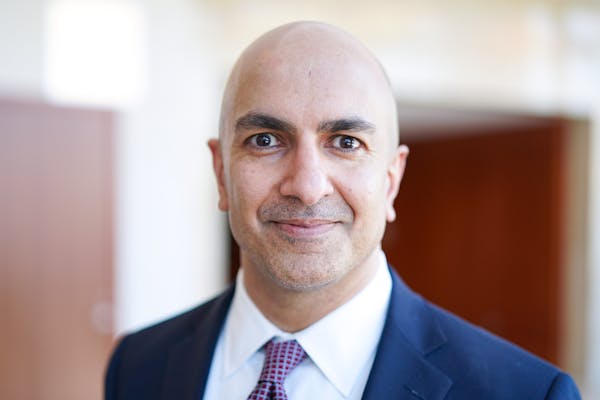As he begins a second five-year term as president of the Federal Reserve Bank of Minneapolis, Neel Kashkari plans to continue to shake things up under both the central bank's brightest spotlight and in some overlooked corners.
Kashkari, a 47-year-old engineer who became a banker and then was brought into government, has become a distinctive figure among Fed officials as the most consistent and outspoken proponent of low interest rates — and for the way he developed his views.
In his first term, he made a point to meet with a wide variety of people, including people of color who hadn't encountered a central banker before, throughout the six states in which the regional bank operates. Even when the economy was flourishing before the pandemic, he learned many people were still looking for work. So when businesses leaders told him they couldn't find workers, he usually replied by suggesting they raise wages.
"I took a very different approach to monetary policy than basically anybody else in the Federal Reserve for the last five years," Kashkari said during an interview. "I said we're not at full employment. We shouldn't be raising interest rates. My views were shaped by the direct conversations I was having with communities around our region."
Building on that approach, Kashkari also recently committed that the Minneapolis Fed will reach out to include more diverse voices for its portion of the beige book, a product the central bank puts out eight times a year that provides anecdotes and snapshots of the economic conditions in each part of the country. It's one of many sources of information that the Fed's rate-setting committee may weigh in deciding whether to raise or lower interest rates.
"We're supposed to be assessing how the economy is doing and we're only talking to business," Kashkari said. "We're not talking to workers. It just feels like it's a very one-sided source of information."
The Minneapolis Fed's researchers have now widened their outreach for the Beige Book to include workers, employment agencies, nonprofits and minority-owned businesses. It's an idea, he added, that came out of one of the recent Racism and the Economy webinars, a series he launched with some of other regional bank presidents last year.
Evidence of the change can be seen in the most recent report from mid-January. The Minneapolis Fed's chapter includes voices of workforce development sources who address the constraints on the labor supply. They note that many of the available jobs don't pay enough or don't include health care benefits to make it worth it for workers to take jobs that would bring higher health risks amid COVID-19. They also nodded to challenges such as the availability of day care, transportation, and broadband internet.
"In almost every dimension, this pandemic is exacerbating disparities and it's just deeply unfair," he said.
Kashkari said the new approach will be even more pronounced in the next Beige Book.
"If it works, I hope it will inspire other Federal Reserve Banks to say, 'You know what? We, too, are going to start talking to a broader range of people.' "
While there has been some progress in getting Americans back to work amid the pandemic, he told the Minnesota Senate's finance committee on Tuesday that a lot of work still remains. While the U.S. unemployment rate has fallen to 6.7%, that doesn't account for the many discouraged workers who have left the labor force. By factoring that in, he said he thinks the true unemployment rate right now is closer to 10%.
"That's still as bad as the worst labor market during the financial crisis of 2008 and 2009," he said.
He added that he hopes the Federal Reserve and Congress continue to be aggressive in taking action to restore the economy. He shrugged off concerns about the U.S. taking on more debt, saying he sees it as "wartime spending."
"Right now, this is like a war, and I believe we have the capacity to do what we need to win the war," he said.
The last recovery, he noted, took a decade.
"We cannot have another 10-year recovery," he said. "That is far too long. The cost to society and the cost to families is far too steep." In 2017, Kashkari created a unit at the Minneapolis Fed called the Opportunity and Inclusive Growth Institute to focus on economic disparities and ways to close them.
"Obviously those disparities have been here for a long time, but it's never been more important to do that work, especially with COVID and George Floyd's murder," he said. "I just think that's a really important investment for us to make for the long term."
He also is spending time on an effort he began last year with former Minnesota Supreme Court Justice Alan Page to add an amendment to the state Constitution that would say that a quality education for all children is a civil right. "I think that's going to be very powerful for Minnesota's future," he said.
Last month, the Federal Reserve Board approved the Kashkari's reappointment to a second five-year term that begins March 1. After moving frequently for jobs at Goldman Sachs, Pimco and the U.S. Treasury, his first five years at the Minneapolis Fed is the longest he's been in any job.
"I'm excited for the next five," he said.
Kavita Kumar • 612-673-4113 Twitter: @kavitakumar
Biden celebrates computer chip factories, pitching voters on American 'comeback'

